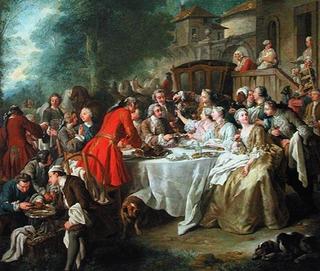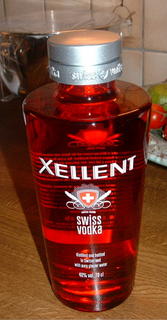The Perfect Sunday
 It has occurred to me that some things in life need to be explained for the benefit of those who have neither the time nor forethought to actually plan and execute the perfect Sunday lunch for friends.
It has occurred to me that some things in life need to be explained for the benefit of those who have neither the time nor forethought to actually plan and execute the perfect Sunday lunch for friends.Sunday is the perfect day, because everyone has finally relaxed from the busy work week and with any luck, on Saturday have completed all those strenuous "pleasure" activities like skiing, hiking and other noble, albeit fruitless, expenditures of time. The stores are all closed, TV offers you little besides the re-runs of Top of the Pops and last Friday's episode of Ready Steady Cook. On Sunday you can really set everything aside and concentrate on the business of leisure.
My idea of leisure has very little to do with being lazy... quite the opposite in fact. Sunday is to me what "maneuvers" are to the to the 5th infantry. Sunday is a day of action.... serious action spent engaging my favorite hobby, cooking.
The perfect Sunday begins days, if not weeks, in advance. Planning is a very important element here...not that anything will actually go according to the plan, but the occasion is of such magnitude and importance that proper planning seems obligatory.
As the Host and Chef I feel I should to explain my plan of attack. My objective is a Sunday lunch with half a dozen of my closest friends spent eating and drinking and talking. It will last no less than six hours and it might last ten or more. Planning a meal of this scale is no easy task, to begin with, you need a good wine...not for the guests...for you....now....in the planning stage. After all, you have to work hard at this planning thing and a little libation is in order for the orchestrator of such important stuff. A pleasant little New World Shiraz will do nicely.
The Guest list: Attendants of this gastronomic sortie should be chosen for a delicate combination of their social grace, culinary stamina, and propensity to absorb alcohol in its various forms. In addition, it is advisable that they have exhibited at least some desire to converse in your native tongue or in-fact, anyone's native tongue. Good conversation is so important, even if you can't understand what your guest is saying. What?
Now that we have the guest list accounted for, we need a menu. The menu is the backbone of the entire event and therefore, requires the most thought. It isn't easy to plan and execute an entire menu, after all there must be millions of things that I have no idea how to cook. Additionally, I tend to become involved in conversation and forget my duties over the stove. What is required here is a menu that is idiot proof, produces rounds and rounds of applause and can be plated and served while discussing Nietche after your fourth aperitif.
Upon arrival, Kir Royals are eagerly thrust into the unsuspecting guest's hand the moment they present Melanie with a lovely hostess gift. A big tray full of "bits of things on sticks" accompanied by the appropriate dipping sauces is presented as Vivaldi's "Spring" from The Four Seasons is playing just loud enough to drown out the neighbor's lawnmower....unless you are fortunate enough to live in Switzerland where cutting the grass is forbidden on Sundays.
While your guests are sipping and nibbling, be sure to point out all of the rare works of art on the walls by the French painter who lived in a garret with the one-eyed cat and a trained rat named Julio?"
Once your guests have begun to settle down and are beginning to feel the effects of the Kir, you can excuse yourself and head for the kitchen to do some last minute prep work. Now, I have a rule of thumb here...if I have had less than two Kirs then I embark on the kitchen alone. More than two and I ask for volunteers. This is good advice, and has prevented me from burning more than one roast, after all 3 pairs of eyes, even if they are crossed, are better than one.
For the second course, I recommend the Spanish Tapas or Italian Antipasti approach, you can get a wide assortment of flavors, most of it can be made in advance or dumped out straight out of the bottle. None if it goes well with wine, so you don't have to serve 50 franc bottles of Chardonnay. Any young acidic white wine, sparkler or light Pinot Noir will function well enough, just make sure they have pretty labels so everyone will be impressed.
The Main Course:
The main course is your opportunity to really show your guests what you are made of! You hold the field! The first assault of Kirs and the battery of first course wines have rendered them putty in your hands! You, on the other hand, are as sober as a judge, because you were cooking and plating so furiously you barely had time for a sip. Now is the time for the "coup des grace", the "piece de resistance"! Each plate is a work of art, a beautiful bouquet of color and aromas with glistening sauces, succulent slices of roast, vegetables in the vibrant greens, oranges and yellows of the season. This Masterpiece requires a short sermon, and your quests will of course allow you this folly because after all, you have worked so hard on their behalf! So with pride, and fortitude you begin your complex explanations of the various ingredients and their preparation, explaining each painstaking process with loving care. Now (half asleep) your guests begin their meal. Mozart's 25th in G is wafting across the room, eyes are rolling back in their sockets, extra sauce is demanded and the fine fumes of a 10 year old Chateauneuf du Pape are slowly and deliberately pulled out of the glass by red noses, smiles are common and broad, and a quite hush fills the room, broken only by Herr Mozart and his crescendos. All is well and everyone is very glad they came.
With the main course over, everyone, including the ladies has pushed themselves back from the table, unabashed stomachs are protruding, a few eyes are closed as their owners are momentarily indisposed. A couple of good women are quietly helping my wife clear the evidence from the table. The dog is fast asleep by the fire and the cat sits meditating on the radiator.
"A walk is in order", someone says! My heart sinks at the thought, but I begin to realize it will be necessary in order to endure the next courses. We all, each in our own time, stand and stretch and one or two re-button their pants. The dog looks at us in disbelief and we all migrate towards the front door.
A walk with friends is perhaps one of the last civilized things left in this hectic world. We move forward at a slow pace that contrasts our hectic lives, hands are placed behind our backs, as we leisurely walk the deepest topics of the day are discussed. The men tend to form a closed circle and discuss various issues in the news, and the women chat together about things of which I have no understanding. If we are lucky, one of the fellows has a handful of cigarillos or better yet a robusto.
Sunday walks are always memorable here in the Berner Oberland, everywhere you look there is beauty. I think it is much easier to digest big lunch with a mountain setting and a little exercise.
About the time your head is beginning to clear, you find that some clever person has led you back home to discover a huge wicker tray full of room temperature cheeses, all working together to create a symphony of an aroma that would make any cheese monger proud. The beautiful Flower Duet by Delibes is filling the room with a sound that haunts us and makes us light headed again. We sit down with renewed interest in the food and wine and begin to divvy up the cheeses while a bottle of Vintage Port slowly makes its way around the table.
As time passes, we sample and critique the cheeses, savoring each and biding our time before the inevitable final course. Then, with the ominous sound of the coffee grinder in the kitchen we realize that the final bell is tolling on our little Sunday Supper, never the less, there are broad smiles as a chocolate souffle is proudly carried into the room, accompanied by a decadently rich Gran Marnier sauce. The souffle is placed on the table then the top is torn open and it is drenched with the warm sauce. Two of the men are hurriedly pouring a round of eau d' vie and Cognac as the dog lets out a satisfied groan from her place by the fire. The day's sun has set, but there remains enough light for everyone to get home before dark.
I ask you, is there a better day than Sunday?








 You will end up with a bread that is thick, chewy, moist and when you press down on it, it springs right back up to its original form.
You will end up with a bread that is thick, chewy, moist and when you press down on it, it springs right back up to its original form. 
 My businesses and my fondness for good food have allowed me to eat at many coveted restaurants over the years, but now I don't visit those places as often as I once did.... they have lost much of their allure for me. These days, I look for examples of what I call "homemade" food... the sort of food that is too simple to charge top-money for. Cassoulets or stews that cook for hours over a slow fire, or maybe the pies that are made with the fresh fruits from the garden, or a perfect hearth-baked bread... these are the foods I seek now. I'm looking for subtle secrets and flavors that were handed down from generation to generation. These dishes can make me just as happy as any of those made from priceless ingredients served in gastronomic temples.
My businesses and my fondness for good food have allowed me to eat at many coveted restaurants over the years, but now I don't visit those places as often as I once did.... they have lost much of their allure for me. These days, I look for examples of what I call "homemade" food... the sort of food that is too simple to charge top-money for. Cassoulets or stews that cook for hours over a slow fire, or maybe the pies that are made with the fresh fruits from the garden, or a perfect hearth-baked bread... these are the foods I seek now. I'm looking for subtle secrets and flavors that were handed down from generation to generation. These dishes can make me just as happy as any of those made from priceless ingredients served in gastronomic temples.

